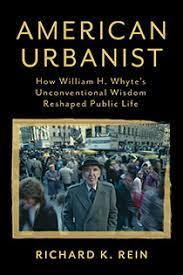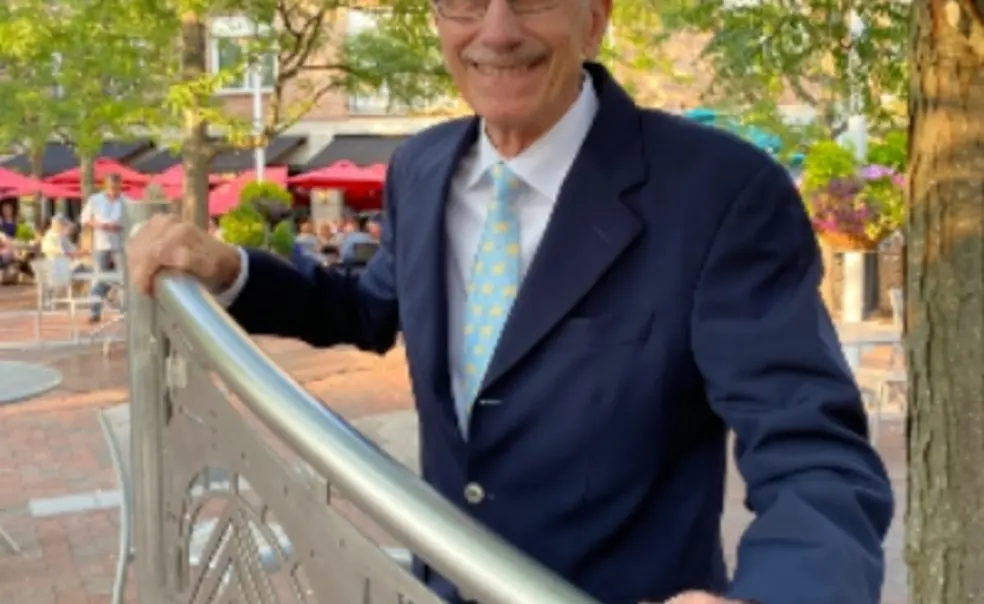Journalist Richard Rein ’69 captures the creative mind of William Whyte ’39 in a new biography
The book: In American Urbanist: How William H. Whyte’s Unconventional Wisdom Reshaped Public Life (Island Press), Richard Rein ’69 captures William Whyte ’39’s creative mind and spirit in this biography. A pioneer of urban design that put people first, Whyte put this on the map with his bestselling book, The Organization Man. Whyte’s work, including his involvement in the 1998 redesign of New York City’s Bryant Park, continues to shape and influence urban landscapes. Rein offers an interesting look at the life, passions, and influence of a multifaceted man who was a pioneer in many ways.

The author: Richard Rein ’69 is an editor and writer specializing in urbanism, regional planning, and placemaking. He has written for Time, People, American Illustrated, and New Jersey Monthly, among other publications. Rein was a founding editor and publisher of the weekly U.S. 1 newspaper, which served the Princeton-Route 1 business corridor. He also works with the nonprofit Princeton Future, which fosters sustainable urbanism.
Excerpt:
Introduction
A Man of Many Missions
This book is about William H. Whyte. Today the name will ring a bell with many people in the field of urban planning, who remember his analyses of cities and suburbs and his observations that showed what made public spaces work, or not work. Whyte stands among the leading American urbanists of the twentieth century, one whose work has become even more relevant in the twenty-first century. But in December 1956, when sociologist C. Wright Mills reviewed a new book called The Organization Man for the New York Times Sunday Book Review, Whyte’s name was virtually unknown except to the readers of Fortune magazine.
Mills, a professor at Columbia University, was a reviewer with impressive credentials. As a Ph.D. sociologist and author of The Power Elite, which declared that American society was controlled by an un-elected upper echelon from the leading business, political, and military institutions, Mills dismissed Whyte as “an energetic reporter” tackling “a very old theme.” While Whyte “adroitly reports various facts and trends,” Mills noted, “he manages to keep the tone of his book that of an earnest, optimistic Boy Scout. The trouble is he really isn’t prepared.” Mills, the academician, may not have been impressed with Whyte’s unconventional and deliberately simple opening sentence: “This book is about the organization man.”
Within six weeks The Organization Man was on the Times best-seller list, where it stayed for most of 1957. Eventually its worldwide sales would be measured in the millions. Not bad for an unprepared Boy Scout.
Soon Whyte could not be categorized so glibly. In 1957 the American Library Association awarded Whyte $5,000 for the best book in the field of contemporary affairs and problems. In 1958, at an alumni program sponsored by Whyte’s alma mater, Princeton University, three academic departments — politics, economics, and sociology — based their discussions on The Organization Man. In 1959, after he had left Fortune, a foundation president trying to interest Whyte in a project asked directly, “What are you now, anyway? Private eye? Pundit? Consultant?” As Whyte’s focus shifted from organizations to the sprawling suburbs in which many organization people lived and then to the cities where many of them ultimately would hope to live, his public stature became even more difficult to describe. He was called a conservationist, an environmentalist, an urbanologist, a sociologist, an urban planner, an urban anthropologist, or — a most convenient catchall — a public intellectual.
In fact, Whyte was a bit of all of these things, but he was also an organization man in the best sense of the term. Rather than dismissing large institutions, Whyte knew how to function within them without being blindly acquiescent to them. His “optimistic premise,” as he wrote in the opening pages of The Organization Man, was “that individualism is as possible in our times as in others.” The fault was not in any of the accoutrements of the organization, from station wagons to gray flannel suits, or in the organization itself. The fault was “in our worship of it.”
Whyte could appreciate organizations of all sorts, especially “deep organizations,” institutions that maintain a sense of public purpose beyond their bottom-line, short-term objectives. Whyte was educated at St. Andrew’s School, which he entered shortly after it was founded by the Du Pont family and which immediately began storing archives — a sign of a deep organization. He studied at Princeton University, founded in 1746. And he enlisted in the United States Marine Corps, where he honed his analytical skills writing for its professional military journal, which began publication in 1916. He worked with other “deep organizations” to effect changes in land use and urban design. These included, among others, Time Inc.’s Fortune magazine, which allowed reporters months to produce a finished article; the Rockefeller Brothers Fund, continuing a philanthropic purpose that began in the nineteenth century; and the New York City Planning Commission, a rare government agency that, in the late 1960s, at least, openly criticized its own work.
Whyte noted in The New York Times in 1986: “Some years ago I wrote a book about the people who work for large organizations. I called them organization men. Some people got mad at me for this. They said I was calling them dirty conformists. But I wasn’t. I was an organization man myself...and I meant no slight.”
This biography rediscovers Whyte’s work as a journalist, an author, an advocate of sustainable land use and engaging public spaces, and, yes, an organization man. It explores his critical thinking, his skepticism, and his curiosity — attributes that would serve anyone well today. This book hopes to encourage readers, and the organizations with which they are affiliated, to tackle the continuing issues — and occasional crises — of our urban and suburban realms.
William Hollingsworth Whyte, known to family and friends as Holly, lived from 1917 to 1999. Born and raised in a small town about twenty-five miles west of Philadelphia, Whyte spent his high school years at a brand-new — and then very small — private boys’ school. A prescient headmaster attributed Whyte’s lackluster grades to poor time management and declared that he could not be “classified in the ordinary way.” On the strength of that recommendation, Whyte was accepted at Princeton, where he majored in English and wrote for the literary magazine. After graduating in 1939 and spending a brief time selling Vicks VapoRub, Whyte eagerly enlisted in the Marine Corps a few months before the attack on Pearl Harbor. His combat service may well have included the classic story line of the small-town boy growing into a man of the world. But during Whyte’s tour as a Marine Corps intelligence officer he also witnessed the tension that exists between an individual and the group around him. And he learned how to distill information into intelligence. For Whyte “military intelligence” was a serious endeavor, not an oxymoron or a comedian’s punch line.
Looking back at the 1950s, when the “silent generation” was just beginning to enter the workforce and the corporate world appeared to favor conformists and company loyalists, the innovation going on in the background is easy to miss. Whyte and his colleagues on the staff at Fortune magazine in the 1950s challenged the corporate establishment in ways that few business magazines today would dare. In 1952, as a thirty-four-year-old reporter, Whyte cast a wary eye on the emerging discipline of business communications and the accompanying loss of “intuition, inspiration, perception, and the like.” Whyte introduced the term “groupthink,” which remains in common use.
In The Organization Man Whyte declared that the Protestant ethic and its survival-of-the-fittest code had quietly been supplanted by a social ethic, in which an individual, “by sublimating himself in the group,” could help “produce a whole that is greater than the sum of its parts.” Survival of the fittest had become survival of those who fit in best. “Group” had become the more important word in “groupthink.” Despite the common perception, however, Whyte did not condemn conformity or organizations. Whyte advised his readers how to work with The Organization and how to — when necessary — resist it. He noted that the lure of The Organization was not limited to business enterprises. It could be experienced just as much in the halls of academe and on the hallowed grounds of religious institutions.
The Organization Man may appear to be only an early accomplishment before Whyte turned to his true calling as an urban critic. But the book set the stage for much of his later work by studying in depth the “packaged villages,” as he referred to the suburbs housing the organization men and their families. These new developments might have met the immediate needs of the postwar baby boom, but they would fail to be a sustainable alternative to vibrant cities and downtowns. “Urban sprawl,” a term used (but not coined) by Whyte in a 1958 Fortune article, became his next area of interest.
In the 1960s, as protests on the streets captured the public’s attention, Whyte and other insiders quietly transformed the conservation movement into the environmental movement and expanded its focus to include the urban landscape as well as the fields and streams of rural America. Whyte and his allies developed their own unconventional tactics to work with, and sometimes against, developers and bureaucrats.
In The Last Landscape, published in 1968, Whyte continued to develop antidotes to the seemingly inexorable spread of urban and suburban sprawl. The book also brought into focus the enduring joys of city life, the potential of the smallest plots of land when put into use rather than left abandoned, and the perils of poor planning. Whyte discovered one egregious example as he edited New York City’s unorthodox master plan of 1969. Privately owned public spaces that were intended to provide public benefits in exchange for increased building sizes turned out to be a bad deal for the public. Identifying what made spaces work for the public and then specifying how zoning laws could be changed to accomplish that consumed Whyte in the 1970s and 1980s. That work became the basis for his film and accompanying book in 1980, The Social Life of Small Urban Spaces.
Published in 1988, City: Rediscovering the Center was Whyte’s last major work. In that book Whyte described the potential downside of corporate moves to the suburbs, and the reasons why small up-and-coming businesses would continue to seek out and thrive in urban locations. In the city, Whyte wrote, “truly critical negotiations” can be done “informally, on common meeting grounds equally accessible to both parties.” These places, such as restaurants, coffee shops, even street corners, “are the heart of the city’s intelligence networks, and a company that cuts itself off from them loses something that no electronic system can ever provide.” Not even Zoom, as noted in chapter 18.
From American Urbanist by Richard K. Rein. Copyright © 2022 by the author. Reproduced by permission of Island Press, Washington, D.C.
Reviews:
“Rein’s comprehensive biography of this icon of the planning and preservation movement focuses on Whyte’s vision and legacy, offering an accessible and worthy source of inspiration for contemporary and future land-use challenges.” — Booklist
“Richard K. Rein’s American Urbanist is a must-read book — not just for those who care about building better cities but for anyone and everyone who cares about more-effective companies and creative organizations. Through Rein’s detailed telling, ‘Holly’ Whyte emerges as among the most important urbanists — and even more so, as one of the most important public intellectuals of our time, shaping the discourse about economy and society, cities and management, innovation and creativity, over the course of the late twentieth and twenty-first centuries.” — Richard Florida, author of Rise of the Creative Class












No responses yet